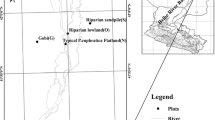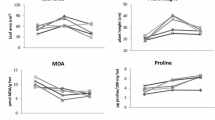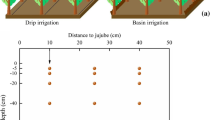Abstract
Lucerne (Medicago sativa L.) is a deep-rooted perennial leguminous forage with high evapo-transpiration rate exceeding the annual precipitation in semi-arid areas of Northwest China. Groundwater might be the potential water sources of lucerne in the area with shallow groundwater table. In this study, stable isotopic compositions of oxygen and hydrogen (δ18O and δD) of different water sources and xylem sap were analyzed to determine the seasonal (April, June, July and August) and topographic (three slope positions) variations in water sources for lucerne growing in Ningxia eastern semi-arid area adjacent to Mu Us Desert characterized by shallow groundwater table. IsoSource software was used to calculate the probable contribution of different water sources to the total plant water uptake. Stomatal conductance, stem water potential, carbon isotope discrimination (Δ13C) of whole plant were also determined for evaluating the water status of lucerne growing at different slope positions. The results showed that soil water content increased as the elevation decreased. Oxygen compositions of soil water in the 0–40 cm profile fluctuated considerably. Soil water δ18O values in deep profile (>3.5 m) were similar to those in groundwater, implying the recharge of groundwater to this soil layer. Highest water utilization rate from deep soil profile (below 350 cm) was recorded for lucerne grown at the slope position 1 (groundwater table depth of 3.5–3.9 m) in April, June and July. The lucernes at slope position 2 (groundwater table depth of 5.8–6.4 m) and slope position 3 (groundwater table depth 7.1–8.3 m) mostly used water from deep soil layers (below 350 cm) during dry period, and turned to use water from superficial soil layer in wet period. Higher yield, Δ13C value of whole plant and stomatal conductance were observed for lucerne grown at the slope position 1 than those at other slope positions. These results indicated that groundwater is a significant water source for transpiration of lucerne grown in Ningxia semi-arid area with shallow groundwater table where lucerne grassland is suggested to be established so as to obtain better yield performance.
Similar content being viewed by others
References
Asbjornsen H, Shepherd G, Helmers M, et al. 2008. Seasonal patterns in depth of water uptake under contrasting annual and perennial systems in the Corn Belt Region of the Midwestern U.S. Plant and Soil, 308(1–2): 69–92.
Bauder J W, Bauer A, Ramirez J M, et al. 1978. Alfalfa water use and production on dryland and irrigated sandy loam. Agronomy Journal, 70(1): 95–99.
Blad B L, Rosenberg N J. 1976. Evaluation of resistance and mass transport evapotranspiration models requiring canopy temperature data. Agronomy Journal, 68(5): 764–769.
Bundt M, Widmer F, Pesaro M, et al. 2001. Preferential flow paths: biological ‘hot spots’ in soils. Soil Biology and Biochemistry, 33(6): 729–738.
Chen X, Hu Q. 2004. Groundwater influences on soil moisture and surface evaporation. Journal of Hydrology, 297(1–4): 285–300.
Chimner R A, Cooper D J. 2004. Using stable oxygen isotopes to quantify the water source used for transpiration by native shrubs in the San Luis Valley, Colorado U.S.A. Plant and Soil, 260(1–2): 225–236.
Dawson T. 1993. Water sources of plants as determined from xylem-water isotopic composition: perspectives on plant competition, distribution, and water relations. In: Ehleringer J R, Hall A E, Farquhar G D. Stable Isotopes and Plant Carbon-water Relations. San Diego: Academic Press Inc, 465–496.
Dawson T E, Ehleringer J R. 1993. Isotopic enrichment of water in the “woody” tissues of plants: implications for plant water source, water uptake, and other studies which use the stable isotopic composition of cellulose. Geochimica et Cosmochimica Acta, 57(14): 3487–3492.
Dawson T E, Pate J S. 1996. Seasonal water uptake and movement in root systems of Australian phraeatophytic plants of dimorphic root morphology: a stable isotope investigation. Oecologia, 107(1): 13–20.
Dunin F X, Smith C J, Zegelin S J, et al. 2001. Water balance changes in a crop sequence with Lucerne. Crop & Pasture Science, 52(2): 247–261.
Eggemeyer K D, Awada T, Harvey F E, et al. 2009. Seasonal changes in depth of water uptake for encroaching trees Juniperus virginiana and Pinus ponderosa and two dominant C4 grasses in a semiarid grassland. Tree Physiology, 29(2): 157–169.
Ehdaie B, Hall A E, Farquhar G D, et al. 1991. Water-use efficiency and carbon isotope discrimination in wheat. Crop Science, 31(5): 1282–1288.
Fan J, Gao Y, Wang Q J, et al. 2014. Mulching effects on water storage in soil and its depletion by alfalfa in the Loess Plateau of northwestern China. Agricultural Water Management, 138: 10–16.
Farquhar G D, Richards R A. 1984. Isotopic composition of plant carbon correlates with water-use efficiency of wheat genotypes. Australian Journal of Plant Physiology, 11(6): 539–552.
Flanagan L B, Ehleringer J R. 1991. Stable isotope composition of stem and leaf water: applications to the study of plant water use. Functional Ecology, 5(2): 270–277.
Han J C, Liu Y S, Luo L T. 2012. Research on the core technology of remixing soil by soft rock and sand in the Maowusu sand land region. China Land Science, 26(8): 87–94. (in Chinese)
Horton J L, Hart S C, Kolb T E. 2003. Physiological condition and water source use of Sonoran Desert riparian trees at the Bill Williams River, Arizona, USA. Isotopes in Environmental and Health Studies, 39(1): 69–82.
Jia Y, Li F M, Wang X L, et al. 2006. Soil water and alfalfa yields as affected by alternating ridges and furrows in rainfall harvest in a semiarid environment. Field Crops Research, 97(2–3): 167–175.
Jia Y, Li F M, Zhang Z H, et al. 2009. Productivity and water use of alfalfa and subsequent crops in the semiarid Loess Plateau with different stand ages of alfalfa and crop sequences. Field Crops Research, 114(1): 58–65.
Jia Y H, Shao M A. 2014. Dynamics of deep soil moisture in response to vegetational restoration on the Loess Plateau of China. Journal of Hydrology, 519: 523–531.
Johnson R C, Bassett L M. 1991. Carbon isotope discrimination and water use efficiency in four cool-season grasses. Crop Science, 31(1): 157–162.
Latta R A, Blacklow L J, Cocks P S. 2001. Comparative soil water, pasture production, and crop yields in phase farming systems with Lucerne and annual pasture in Western Australia. Crop & Pasture Science, 52(2): 295–303.
Li F M, Zhang Z W. 1991. The study on water use of the alfalfa grassland and the Stipa bungeana grassland in Ningxia Yanchi. Acta Phytoecologica et Geobotanica Sinica, 15(4): 319–329. (in Chinese)
Li M, Su X X, Pan Z L. 2004. Counterplan and present condition of drinking water in Yanchi county of Ningxia. Ningxia Engineering Technology, 3(4): 395–397. (in Chinese)
Li Y S, Huang M B. 2008. Pasture yield and soil water depletion of continuous growing alfalfa in the Loess Plateau of China. Agriculture, Ecosystems & Environment, 124(1–2): 24–32.
Liu H W, Xu M, Guan Q H. 2012. Variation characteristics and influencing factors of hydrogen-oxygen stable isotope in precipitation of Yinchuan area. Water Sciences and Engineering Technology, (1): 88–90. (in Chinese)
McCole A A, Stern L A. 2007. Seasonal water use patterns of Juniperus ashei on the Edwards Plateau, Texas, based on stable isotopes in water. Journal of Hydrology, 342(3–4): 238–248.
O'Grady A P, Eamus D, Cook P G, et al. 2006. Groundwater use by riparian vegetation in the wet-dry tropics of northern Australia. Australian Journal of Botany, 54(2): 145–154.
Phillips D L, Newsome S D, Gregg J W. 2005. Combining sources in stable isotope mixing models: alternative methods. Oecologia, 144(4): 520–527.
Raza A, Friedel J K, Moghaddam A, et al. 2013. Modeling growth of different Lucerne cultivars and their effect on soil water dynamics. Agricultural Water Management, 119(1): 100–110.
Ridley A M, Christy B, Dunin F X, et al. 2001. Lucerne in crop rotations on the Riverine Plains. 1. The soil water balance. Crop & Pasture Science, 52(2): 263–277.
Romero-Saltos H, da S L Sternberg L, Moreira M Z, et al. 2005. Rainfall exclusion in an eastern Amazonian forest alters soil water movement and depth of water uptake. American Journal of Botany, 92(3): 443–445.
Rossatto D R, de Carvalho Ramos Silva L, Villalobos-Vega R, et al. 2012. Depth of water uptake in woody plants relates to groundwater level and Vegetation structure along a topographic gradient in a Neotropical savanna. Environmental and Experimental Botany, 77: 259–266.
Saha A K, da Silviera Lobo O’Reilly Sternberg L, Miralles-Wilhelm F. 2009. Linking water sources with foliar nutrient status in upland plant communities in the Everglades National Park, USA. Ecohydrology, 2(1): 42–54.
Shafroth P B, Stromberg J C, Patten D T. 2000. Woody riparian vegetation response to different alluvial water table regimes. Western North American Naturalist, 60(1): 66–76.
Shen Y Y, Li L L, Chen W, et al. 2009. Soil water, soil nitrogen and productivity of Lucerne-wheat sequences on deep silt loams in a summer dominant rainfall environment. Field Crops Research, 111(1–2): 97–108.
Soylu M E, Kucharik C J, Loheide II S P. 2014. Influence of groundwater on plant water use and productivity: development of an integrated ecosystem–variably saturated soil water flow model. Agricultural and Forest Meteorology, 189–190: 198–210.
Tang K L, Feng X H. 2001. The effect of soil hydrology on the oxygen and hydrogen isotopic compositions of plants’ source water. Earth and Planetary Science Letters, 185(3–4): 355–367.
Thorburn P J, Walker G R, Ehleringer J, et al. 1993. The source of water transpired by Eucalyptus camaldulensis: soil, groundwater, or streams?. In: Ehleringer J R, Hall A E, Farquhar G D. Stable Isotopes and Plant Carbon-Water Relations. San Diego, Calif., USA: Academic Press Limited Company, 511–527.
Wang L, Mu Y, Zhang Q F, et al. 2013. Groundwater use by plants in a semi-arid coal-mining area at the Mu Us Desert frontier. Environmental Earth Sciences, 69(3): 1015–1024.
Ward P R, Dunin F X, Micin S F. 2002. Water use and root growth by annual and perennial pastures and subsequent crops in a phase rotation. Agricultural Water Management, 53(1–3): 83–97.
West A G, Hultine K R, Sperry J S, et al. 2008. Transpiration and hydraulic strategies in a piñon-juniper woodland. Ecological Applications, 18(4): 911–927.
Xu D M, Wang K, Long S P. 2008. Vegetation characteristics and soil properties in the transitional zone in south fringe of Mu Us Sandy Land. Bulletin of Soil and Water Conservation, 28(5): 39–43, 47. (in Chinese)
Xu H, Li Y. 2006. Water-use strategy of three central Asian desert shrubs and their responses to rain pulse events. Plant and Soil, 285(1–2): 5–17.
Yeh P J F, Eltahir E A B. 2005. Representation of water table dynamics in a land surface scheme. Part II: subgrid variability. Journal of Climate, 18(12): 1881–1901.
Yepez E A, Williams D G, Scott R L, et al. 2003. Partitioning overstory and understory evapotranspiration in a semiarid savanna woodland from the isotopic composition of water vapor. Agricultural and Forest Meteorology, 119(1–2): 53–68.
Yin L H, Hou G C, Dou Y, et al. 2011. Hydrogeochemical and isotopic study of groundwater in the Habor Lake Basin of the Ordos Plateau, NW China. Environmental Earth Sciences, 64(6): 1575–1584.
York J P, Person M, Gutowski W J, et al. 2002. Putting aquifers into atmospheric simulation models: an example from the Mill Creek Watershed, northeastern Kansas. Advances in Water Resources, 25(2): 221–238.
Zencich S J, Froend R H, Turner J V, et al. 2002. Influence of groundwater depth on the seasonal sources of water accessed by Banksia tree species on a shallow, sandy coastal aquifer. Oecologia, 131(1): 8–19.
Zhang E Y, Shi Y C, Gao C R, et al. 2009. Regional geology and hydrogeology of the Yellow River basin. Bulletin of the Geological Survey of Japan, 60(1–2): 19–32.
Zhu L, Li S H, Liang Z S, et al. 2010. Relationship between yield, carbon isotope discrimination and stem carbohydrate concentration in spring wheat grown in Ningxia irrigation region (North-west China). Crop and Pasture Science, 61(9): 731–742.
Zhu L, Wang Z H, Mao G L, et al. 2014. Water uptake from different soil depths for halophytic shrubs grown in Northern area of Ningxia plain (China) in contrasted water regimes. Journal of Plant Interactions, 9(1): 26–34.
Author information
Authors and Affiliations
Corresponding author
Rights and permissions
About this article
Cite this article
Zhu, L., Zhang, H., Gao, X. et al. Seasonal patterns in water uptake for Medicago sativa grown along an elevation gradient with shallow groundwater table in Yanchi county of Ningxia, Northwest China. J. Arid Land 8, 921–934 (2016). https://doi.org/10.1007/s40333-016-0017-8
Received:
Revised:
Accepted:
Published:
Issue Date:
DOI: https://doi.org/10.1007/s40333-016-0017-8




